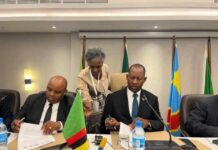Zhang Chenyang is 24 years old. Every morning he rises early and walks thirty minutes along dusty, rutted roads to work. He lives alone and is not allowed to go out after dark. “It is very lonely,” he confesses. A large map of the world labeled in Chinese covers the chipped plaster of his office walls. A knock on the door and three students burst in. “Ni hao!” they all greet him. He smiles at them and hands them the books they ask to borrow. “It is so hard to teach here,” he explains. “There are not enough texts and no money to make copies.” Mr. Zhang teaches eighth graders at a public school in Lusaka, Zambia, one of five government secondary schools in the country now offering Chinese language instruction.
Engaging in a long-term domestic education policy represents a commitment by the Chinese government to Zambia rarely seen outside the economic sphere. Zambia has long been at the forefront of Sino-African relations, as the home of multiple major “firsts”: formal diplomatic relationship, foreign aid project, and operational Economic and Trade Cooperation Zone. As in much of Africa, China is responsible for most major infrastructure projects in the country, and has invested over $1 billion in Zambia’s most profitable industries (mining, construction, and manufacturing). However, Chinese presence to date has remained largely compartmentalized in these sectors.
A representative from the Chinese Embassy first pitched the idea to the Ministry in January 2013. “It was all very simple!” the Director of Curriculum in Lusaka exclaimed: the Confucius Institute at the University of Zambia volunteered to recruit volunteer teachers from China and supply the curriculum, and the Ministry of Education agreed to house the instructors. This type of true collaboration is rare; typical ventures extend only as far as a Chinese company implementing a Zambian government project.
Educating Zambians in Mandarin goes far beyond the limited reach of the few existing cultural exchange initiatives. Chinese government-run Confucius Institutes have quickly established a global presence in ninety-six countries including Zambia. However, the influence of these language and culture centers remains limited to the small sphere of students electing to participate in their programming. Scholarships for African students to study in China similarly reach only a narrow sliver of the population. Teaching Chinese language to public school students reaches deep to a broad and fundamental level of Zambian society. With recent curriculum reforms, students will soon be required to study a foreign language; since most public schools are only able to offer one language, studying Chinese will become de facto mandatory for a large group of students.
A lack of cultural understanding is broadly responsible for existing tensions between Zambians and Chinese migrants. The lack of Chinese integration has led to xenophobic Zambian political campaigns and exacerbated Chinese exploitation of their Zambian employees. Language does not exist in a void; students will not only learn vocabulary and grammar but also societal and cultural norms. “China is very amazing!” the group of students I interviewed at Nyumba Yanga Secondary School in Lusaka exclaimed. They all plan to continue studying Chinese; the majority said they hoped to move to China when they are old enough. Language as a pathway to cultural understanding is not a new strategy; it is, however, groundbreaking in the China-Africa context. This program has the potential to jumpstart integration and encourage cooperation on multiple fronts.
Most media coverage has portrayed the Chinese as neo-colonialist exploiters of Zambian national resources. These “rise of China” advocates will likely warn that the new language program is merely a bid by the Chinese government to expand its influence overseas. Though certainly not a humanitarian gesture, the initiative is more complex than this argument allows. China will unquestionably expand its regional soft power, but Zambia also stands to reap substantial benefits.
Specifically, Chinese-speaking Zambians could help resolve one of the most contentious aspects of the Chinese presence in Africa: Chinese labor imports. Most major Chinese companies hire almost entirely from China (to the exclusion of Zambian workers), citing language and cultural differences. The Zambian government should harness this opportunity to supply local labor to one of country’s largest employers. Chinese language instruction in Zambian public schools is a new cultural facet of the Sino-Zambian relationship, yet illustrates a familiar trend. The program will be a win-win only if the Zambian government steps up to achieve these domestic goals.
Mandarin is on track to become the most widely taught foreign language in Zambian public schools. If Chinese language instruction penetrates the curriculum to the extent of Spanish, French, or even German in American classrooms, both China-Zambia relations and Zambian society could change fundamentally. However, the Zambian government’s ability to carry out the proposed plan is doubtful; only three of the ten Zambian schools selected for pilot language instruction began on schedule. The program’s substantial soft power and labor market potential will only be realized with more widespread implementation. The Chinese government may decide to play a more active role in this expansion; however, the program’s success truly depends on whether the Zambian government fully capitalizes on this opportunity or merely rides on Beijing’s coattails.

 JOIN DRIVERN TAXI AS PARTNER DRIVER TODAY!
JOIN DRIVERN TAXI AS PARTNER DRIVER TODAY!











